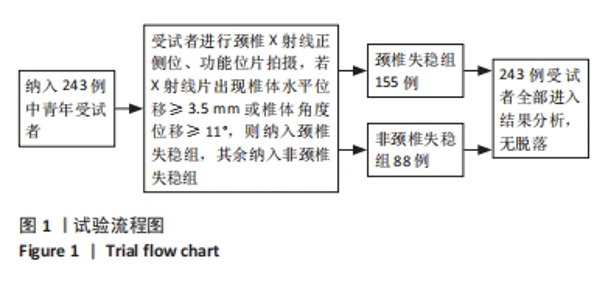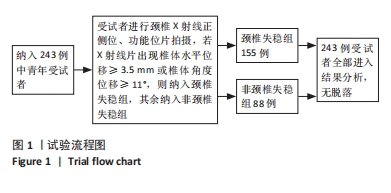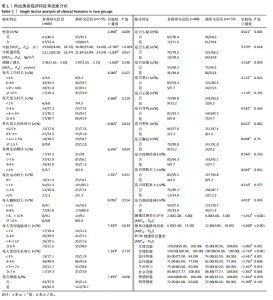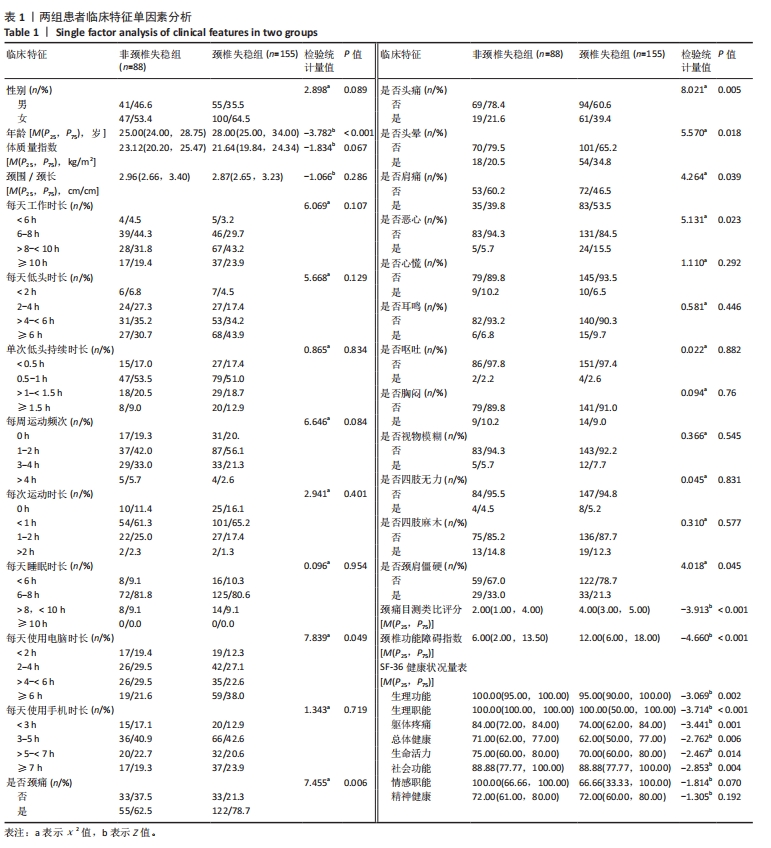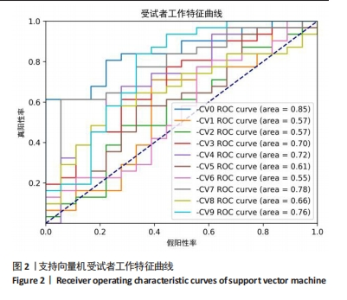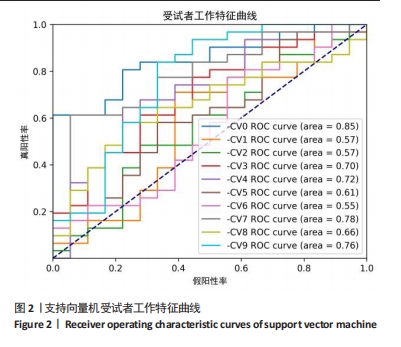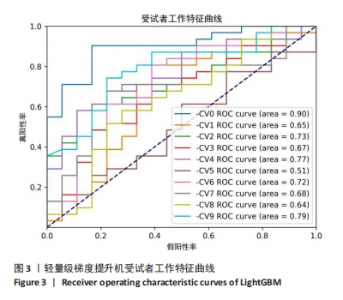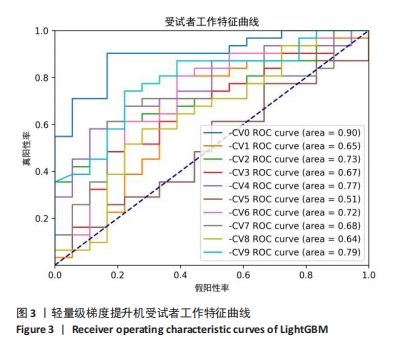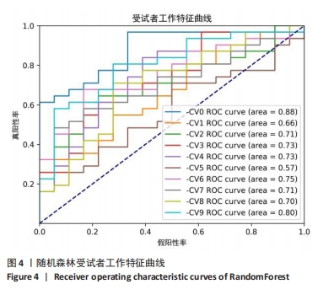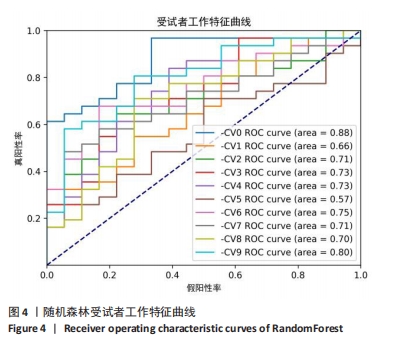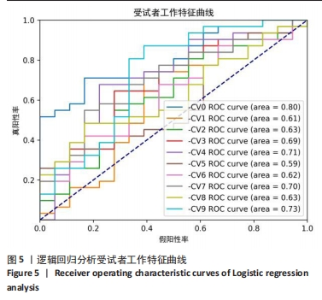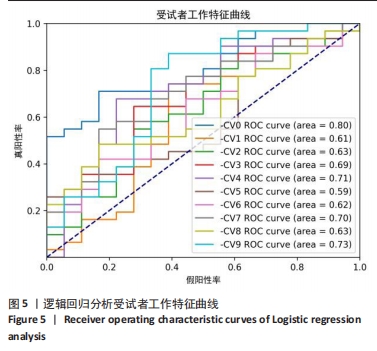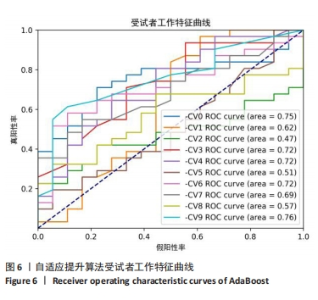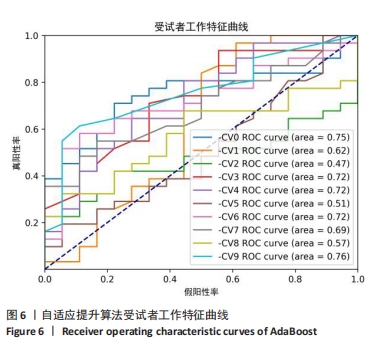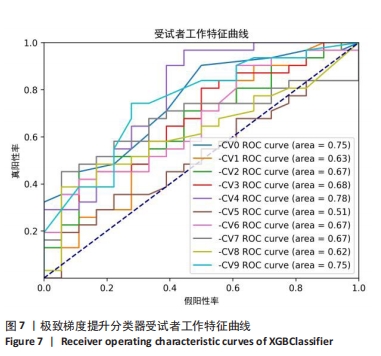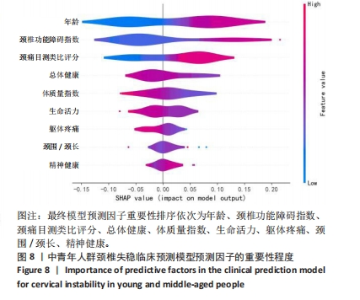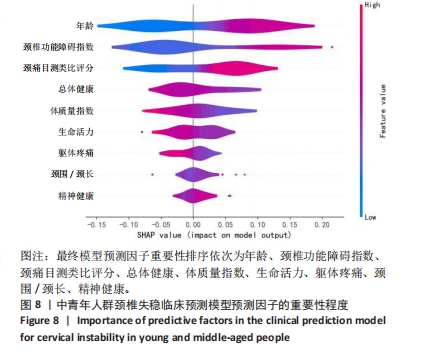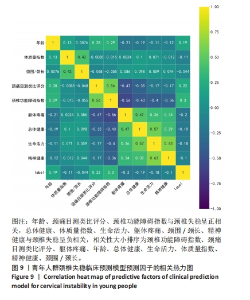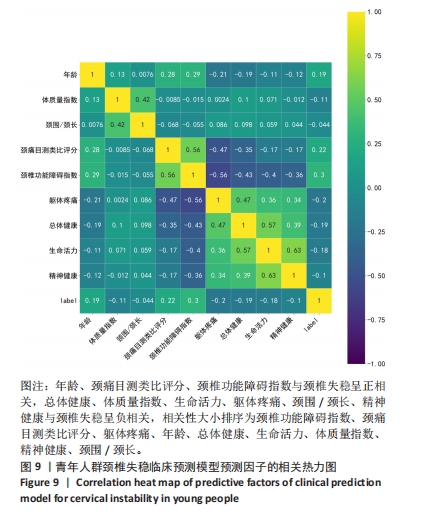Chinese Journal of Tissue Engineering Research ›› 2025, Vol. 29 ›› Issue (33): 7203-7210.doi: 10.12307/2025.853
Previous Articles Next Articles
Development of a clinical prediction model for cervical instability in young and middle-aged adults based on machine learning
Li Jing, Lu Guangqi, Zhuang Minghui, Cui Ying, Yu Zhangjingze, Sun Xinyue, Ma Mingming, Zhu Liguo, Yu Jie
- Wangjing Hospital, China Academy of Chinese Medical Sciences, Beijing 100102, China
-
Received:2024-08-01Accepted:2024-10-25Online:2025-11-28Published:2025-04-12 -
Contact:Yu Jie, Chief physician, Doctoral supervisor, Wangjing Hospital, China Academy of Chinese Medical Sciences, Beijing 100102, China -
About author:Li Jing, Master candidate, Wangjing Hospital, China Academy of Chinese Medical Sciences, Beijing 100102, China -
Supported by:National Natural Science Foundation of China (General Program), No. 82074455 (to YJ); Beijing Science and Technology Plan Capital Clinical Diagnosis and Treatment Technology Research and Transformation Application Project, No. Z211100002921023 (to YJ); China Academy of Chinese Medical Sciences Science and Technology Innovation Project, No. CI2021A02002 (to YJ); High-Level Chinese Medicine Hospital Construction Project Clinical Evidence-based Research Special Project of Wangjing Hospital of China Academy of Chinese Medical Sciences, No. WJYY-XZKT-2023-01 (to YJ)
CLC Number:
Cite this article
Li Jing, Lu Guangqi, Zhuang Minghui, Cui Ying, Yu Zhangjingze, Sun Xinyue, Ma Mingming, Zhu Liguo, Yu Jie. Development of a clinical prediction model for cervical instability in young and middle-aged adults based on machine learning[J]. Chinese Journal of Tissue Engineering Research, 2025, 29(33): 7203-7210.
share this article
Add to citation manager EndNote|Reference Manager|ProCite|BibTeX|RefWorks

2.5 预测模型的评价 由表2可知,6种分类模型的十折交叉验证平均F1分数、平均精确率、平均召回率和平均AUC值,评价指标分别为:支持向量机模型(F1=0.716 1,精确率=0.732 9、召回率=0.703 2、AUC=0.675 8)、 轻量级梯度提升机模型(F1=0.419 9,精确率=0.581 2、召回率=0.348 4、AUC=0.705 5)、随机森林模型(F1=0.632,精确率= 0.825 7、召回率=0.516 1、AUC=0.725 4)、逻辑回归分析模型(F1=0.406 3,精确率=0.743 8、召回率=0.303 2、AUC=0.671 1)、自适应提升算法模型(F1=0.700 4,精确率=0.699 2、召回率=0.703 2、AUC=0.654 2)、极致梯度提升分类器模型(F1=0.400 7,精确率=0.552 1、召回率=0.358 1、AUC=0.672 7)。随机森林模型AUC最高,为0.725 4,具有良好的预测能力。由图4可知,第1折AUC最高,为0.88,所以选取该折年龄、体质量指数、颈围/颈长、颈痛目测类比评分、颈椎功能障碍指数、躯体疼痛、总体健康、生命活力、精神健康9个预测因子构建模型。"
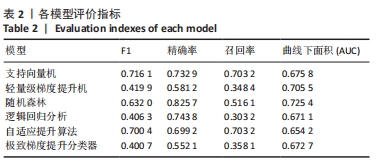
| [1] GUI L, SAVINI R, MARTUCCI E, et al. Diagnosis and treatment of cervical instability. Ital J Orthop Traumatol. 1982;8(2):131-144. [2] 曾恒,周红海.颈椎生物力学平衡变化的研究进展[J].中国中医骨伤科杂志,2008(2):62-63. [3] 李帅林,吴嘉容,孔令军.退行性下颈椎失稳症的临床诊疗进展[J].河北中医,2017,39(10):1592-1596. [4] ZHUANG L, WANG L, XU D, et al. Association between excessive smartphone use and cervical disc degeneration in young patients suffering from chronic neck pain. J Orthop Sci. 2021;26(1):110-115. [5] BRAITMAN LE, DAVIDOFF F. Predicting clinical states in individual patients. Ann Intern Med. 1996;125(5):406-412. [6] 高永祥,张晋昕.Logistic回归分析的样本量确定[J].循证医学,2018, 18(2):122-124. [7] WHITE AA, JOHNSON RM, PANJABI MM, et al. Biomechanical analysis of clinical stability in the cervical spine. Clin Orthop Relat Res. 1975; 109(1):85-96. [8] HE S, RENNE A, ARGANDYKOV D, et al. Comparison of an Emoji-Based Visual Analog Scale With a Numeric Rating Scale for Pain Assessment. JAMA. 2022;328(2):208-209. [9] VAISHNAV AS, GANG CH, IYER S, et al. Correlation between NDI, PROMIS and SF-12 in cervical spine surgery. Spine J. 2020;20(3):409-416. [10] WARE JE JR, SHERBOURNE CD. The MOS 36-item short-form health survey (SF-36). I. Conceptual framework and item selection. Med Care. 1992;30(6):473-483. [11] ALBA AC, AGORITSAS T, WALSH M, et al. Discrimination and Calibration of Clinical Prediction Models: Users’ Guides to the Medical Literature. JAMA. 2017;318(14):1377-1384. [12] STEYERBERG EW, VICKERS AJ, COOK NR, et al. Assessing the performance of prediction models: a framework for traditional and novel measures. Epidemiology. 2010;21(1):128-138. [13] GBD 2021 NECK PAIN COLLABORATORS. Global, regional, and national burden of neck pain, 1990-2020, and projections to 2050: a systematic analysis of the Global Burden of Disease Study 2021. Lancet Rheumatol. 2024;6(3):e142-e155. [14] SHIM GY, CHOI J, KIM HJ, et al. Global, Regional, and National Burden of Spine Pain, 1990-2019: A Systematic Analysis of the Global Burden of Disease Study 2019. Arch Phys Med Rehabil. 2024;105(3):461-469. [15] 王向阳,高晔,龚福太,等.不同牵引角度治疗青少年颈椎失稳症120例[J].陕西医学杂志,2019,48(1):80-82. [16] 张丽蓉,连红强,郝莹.慢性非特异性颈痛疼痛机制研究进展[J].医学研究与战创伤救治,2023,36(9):978-981. [17] ZHUANG L, WANG L, XU D, et al. Association between excessive smartphone use and cervical disc degeneration in young patients suffering from chronic neck pain. J Orthop Sci. 2021;26(1):110-115. [18] 王宏岩,何亮亮,窦智,等.颈源性头痛发病机制和诊断的研究进展[J].中国疼痛医学杂志,2023,29(9):685-690. [19] ZHANG Y, ZHOU F, SUN Y. Assessment of health-related quality of life using the SF-36 in Chinese cervical spondylotic myelopathy patients after surgery and its consistency with neurological function assessment: a cohort study. Health Qual Life Outcomes. 2015;13:39. [20] BATTISTELLI M, MAZZUCCHI E, MUSELLI M, et al. The Role of Psychosomatic Traits in Tailored Workup for Anterior Cervical Discectomy and Fusion-A Case Series. J Pers Med. 2024;14(5):454. [21] TRELEAVEN J. The Role of the Cervical Spine in Dizziness. J Neurol Phys Ther. 2024 1;48(4):1-10. [22] AZODI CB, TANG J, SHIU SH. Opening the black box: interpretable machine learning for geneticists. Trends Genet. 2020;36:442-455. [23] WANG C, TIAN F, ZHOU Y, et al. The incidence of cervical spondylosis decreases with aging in the elderly, and increases with aging in the young and adult population: a hospital-based clinical analysis. Clin Interv Aging. 2016;11:47-53. [24] MATSUMOTO M, OKADA E, TOYAMA Y, et al. Tandem age-related lumbar and cervical ntervertebral disc changes in asymptomatic subjects. Eur Spine J. 2013;22(4):708-713. [25] 刘承鑫,李翔宇,王宇,等.不同年龄颈椎病患者颈椎椎间盘退行性变与颈椎矢状位参数之间的关系[J].脊柱外科杂志,2022, 20(2):116-120. [26] 夏凌,李交杰,顾一伟,等.颈围和体质指数与颈肌强度的相关性[J].解放军预防医学杂志,2013,31(5):432-433. [27] BLIZZARD L, GRIMMER KA, DWYER T. Validity of a measure of the frequency of headaches with overt neck involvement, and reliability of measurement of cervical spine anthropometric and muscle performance factors. Arch Phys Med Rehabil. 2000;81(9):1204-1210. [28] WU Y, WU J, QIN T, et al. Cervical facet joint degeneration, facet joint angle and paraspinal muscle degeneration are correlated with degenerative cervical spondylolisthesis at C4/5: a propensity score-matched study. Spine J. 2024:S1529-9430(24)00920-3. |
| [1] | Li Jiagen, Chen Yueping, Huang Keqi, Chen Shangtong, Huang Chuanhong. The construction and validation of a prediction model based on multiple machine learning algorithms and the immunomodulatory analysis of rheumatoid arthritis from the perspective of mitophagy [J]. Chinese Journal of Tissue Engineering Research, 2025, 29(在线): 1-15. |
| [2] | Wang Mi, Ma Shujie, Liu Yang, Qi Rui. Identification and validation of characterized gene NFE2L2 for ferroptosis in ischemic stroke [J]. Chinese Journal of Tissue Engineering Research, 2025, 29(7): 1466-1474. |
| [3] | Liu Yani, Yang Jinghuan, Lu Huihui, Yi Yufang, Li Zhixiang, Ou Yangfu, Wu Jingli, Wei Bing . Screening of biomarkers for fibromyalgia syndrome and analysis of immune infiltration [J]. Chinese Journal of Tissue Engineering Research, 2025, 29(5): 1091-1100. |
| [4] | Yang Bin, Tao Guangyi, Yang Shun, Xu Junjie, Huang Junqing . Visualization analysis of research hotspots of artificial intelligence in field of spinal cord nerve injury and repair [J]. Chinese Journal of Tissue Engineering Research, 2025, 29(4): 761-770. |
| [5] | Yang Dingyan, Yu Zhenqiu, Yang Zhongyu. Machine learning-based analysis of neutrophil-associated potential biomarkers for acute myocardial infarction [J]. Chinese Journal of Tissue Engineering Research, 2025, 29(36): 7909-7920. |
| [6] | Tian Yushi, Fu Qiang, Li Ji . Bioinformatics identification and validation of mitochondrial genes related to acute myocardial infarction [J]. Chinese Journal of Tissue Engineering Research, 2025, 29(31): 6697-6707. |
| [7] | Song Haoran, Zhang Yuqiang, Gu Na, Zhi Xiaodong, Wang Wei. Visualization analysis of artificial intelligence in bone trauma research based on Citespace [J]. Chinese Journal of Tissue Engineering Research, 2025, 29(3): 493-502. |
| [8] | Zhang Ziyu, Chen Longhao, Sheng Wei, Lyu Hanzhe, Shen Ying, Wang Binghao, Lyu Zhizhen, Lyu Lijiang. Application of artificial intelligence in the diagnosis and treatment of lumbar disc herniation: evolution towards standardization, efficiency, and precision of diagnosis and treatment methods [J]. Chinese Journal of Tissue Engineering Research, 2025, 29(29): 6269-6276. |
| [9] | Wang Jiaru, Zhang Ying, Yang Yong, Qi Wen, Xiao Huaye, Ma Qiuping, Yang Lianzhao, Luo Ziwei, He Yaqing, Zhang Jiangyin, Wei Jiawen, Meng Yuan, Tan Silian. Systematic review of machine learning models for predicting functional recovery and prognosis in stroke [J]. Chinese Journal of Tissue Engineering Research, 2025, 29(29): 6317-6325. |
| [10] | Hao Maochen, Ma Chao, Liu Kai, Liu Kexin, Meng Lingting, Wang Xingru, Wang Jianzhong. Bioinformatics screening of key genes for endoplasmic reticulum stress in osteoarthritis and experimental validation [J]. Chinese Journal of Tissue Engineering Research, 2025, 29(26): 5632-5641. |
| [11] | Li Jiagen, Chen Yueping, Huang Keqi, Chen Shangtong, Huang Chuanhong. Rheumatoid arthritis from the perspective of mitophagy: interaction analysis based on multiple machine learning algorithms [J]. Chinese Journal of Tissue Engineering Research, 2025, 29(26): 5595-5607. |
| [12] | Qiu Boyuan, Liu Fei, Tong Siwen, Ou Zhixue, Wang Weiwei. Bioinformatics identification and validation of aging key genes in hormonal osteonecrosis of the femoral head [J]. Chinese Journal of Tissue Engineering Research, 2025, 29(26): 5608-5620. |
| [13] | Wu Yingkai, Shi Gaolong, Xie Zonggang . Weighted gene co-expression network analysis and machine learning identification of key genes in rheumatoid arthritis synovium [J]. Chinese Journal of Tissue Engineering Research, 2025, 29(2): 294-301. |
| [14] | Wei Mengli, Zhong Yaping, Gui Huixian, Zhou Yiwen, Guan Yeming, Yu Shaohua. Sports injury prediction model based on machine learning [J]. Chinese Journal of Tissue Engineering Research, 2025, 29(2): 409-418. |
| [15] | Xu Daxing, Tu Zesong, Ji Muqiang, Xu Weipeng, Niu Wei. Machine learning prediction of the risk of secondary screw perforation after plate internal fixation for proximal humerus fractures [J]. Chinese Journal of Tissue Engineering Research, 2025, 29(15): 3179-3187. |
| Viewed | ||||||
|
Full text |
|
|||||
|
Abstract |
|
|||||
